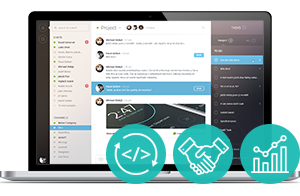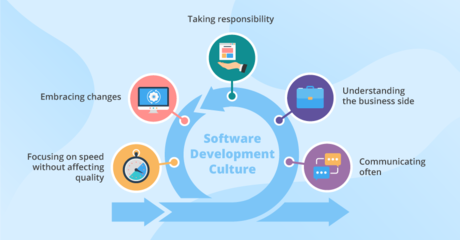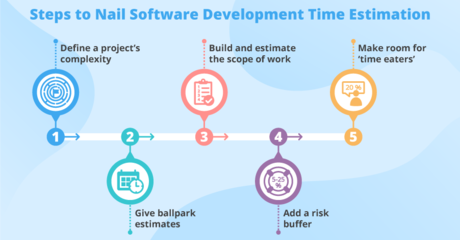Editor’s note: In this article, Boris shares how to achieve high-profile team goals based on insights from one of our long-term projects. And if you need more substantial backup in reaching your development goals, we invite you to discover what services of ScienceSoft’s outsourced teams can help keep your project on track.
At ScienceSoft, software development team goals are commonly based on what we commit to in a project’s Service Level Agreement (SLA), which includes 3 principal goals:
- Meet project requirements.
- Deliver on time.
- Keep the quality high.
I’ll show how to reach these goals in a steady and efficient way. For this, I’ll dive into the example of our software development outsourcing project for a global marketing agency that lasted for several years of continuous software evolution based on the Scrum methodology.
Note: The article explores the ways to achieve goals with an already established team. If you don’t have one yet, I recommend starting with my article on building an efficient team and creating a productive working environment.

Goal #1. Meet the requirements
To reach this goal, you need to create a solid software specification but stay flexible for change requests throughout the project. Here are a few tips from our project that I find especially helpful:
- Ensure a shared understanding of software among the parties involved. At the initial stages of the project, our business analysts conducted on-site workshops with the customer’s stakeholders and our team to finalize the main concept of software requirements, architecture and design, and ensure everybody was looking in the same direction.
- Provide the full-fledged change management process. To handle change requests without delays and prevent their affecting existing functionality, each change request was reflected in the format of a business proposal and added to the project roadmap. Such business proposals included goals, an effect on the project, an amount of work, and a time estimation. And after the changes were implemented, stakeholders on the customer’s side performed user acceptance testing to give the final approval.
Goal #2. Deliver on time
ScienceSoft’s experience shows that the recipe for meeting deadlines, especially in such long-term iterative projects as the one we discuss in this article, has two aspects:
- Routine automation. The team automated the whole delivery pipeline within the DevOps approach to speed up the development and ensure smooth integration of new functionality with the working solution in the future.
- Continuous progress tracking. To stay focused and plan day-to-day efforts more efficiently, the team used burndown charts that showed how close they were to completing the sprint’s scope of work. And to plan reasonable workloads for future iterations, they looked at a team velocity chart reflecting the average amount of work finished per iteration. Such charts become more reliable as the project moves forward, say, after 5 iterations and further.
Goal #3. Keep the quality high
However tight the timeline is, avoid accelerating software development at the expense of quality. Otherwise, you risk shifting focus from development to fighting growing technical debt (you can read more about it in my article on managing tech debt). I recommend thinking about quality already at the very beginning of a project when you’re setting up the processes. For example, safeguarding our project’s quality included the following cornerstones:
- Agile culture nurtured in the team. Our software development team was guided by agile principles that help deliver quality software in the fast-paced market: focusing on speed without affecting quality, sharing responsibility, understanding the business side, and communicating often. I’ve described ScienceSoft’s practices on each of the principles in this article.
- Code reviews. Running automated code reviews to measure code quality (with such metrics as Cyclomatic Complexity, Depth of Inheritance, Class Coupling, and Lines of Code) was a part of the development routine to avoid code complexity that brings problems with software maintenance.
- Continuous testing. In the framework of the DevOps approach, the team established continuous testing to spot quality risks early, before they slick into production.
Final tips on software development team goals
I always recommend that project managers work out a plan on achieving goals in collaboration with the team, as it helps receive valuable input from different perspectives.
However, reaching goals is sometimes complicated by the lack of targeted expertise or pressing deadlines. Overstraining a team to keep up with demanding goals is likely to bring the opposite effect. If that’s something you’ve experienced, you may consider outsourcing a part of the project as an efficient and cost-effective solution to cover the resource gaps and deliver software as planned. Our software development team would be glad to help, just let us know.

Looking for an outsourcing partner to take over your software development project or the entire pipeline of projects? ScienceSoft is ready to support your business growth and digital transformation initiatives.


